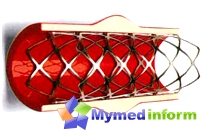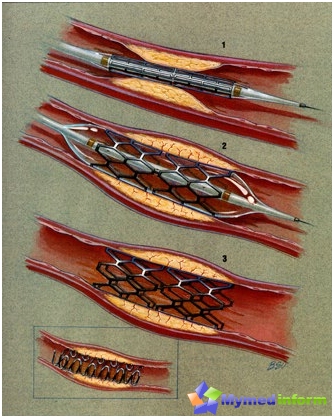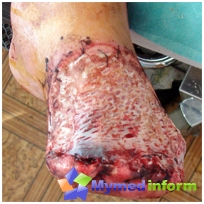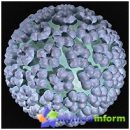Sleepy artery stenting is a procedure consisting in the installation of a narrowed vessel of a thin wire design in the form of a cylinder playing the role of a frame - stent. The stent is usually installed in a pre-expanded artery.
Content
Sleeping artery stenting – This is a procedure consisting in the installation in the disclosure of a narrowed vessel of a thin wire design in the form of a cylinder playing the role of a frame – Stent. The stent is usually installed in a pre-expanded artery.
 The narrowing of the carotid arteries is observed during atherosclerosis – disease affecting all arteries. The main manifestation of atherosclerosis – Appearance on the inner wall of the artery of atherosclerotic plaques. These plaques consist of cholesterol, calcium and fibrous fabric. Gradually increasing in volume, the plaques narrow the clearance of the arteries and disturb the normal blood flow. When plaques are formed in the lumen of the carotid arteries, the brain circulation is disturbed.
The narrowing of the carotid arteries is observed during atherosclerosis – disease affecting all arteries. The main manifestation of atherosclerosis – Appearance on the inner wall of the artery of atherosclerotic plaques. These plaques consist of cholesterol, calcium and fibrous fabric. Gradually increasing in volume, the plaques narrow the clearance of the arteries and disturb the normal blood flow. When plaques are formed in the lumen of the carotid arteries, the brain circulation is disturbed.
Sleepy artery begin with aortic arc. Around the middle of the neck, they are divided into outdoor and internal. Outdoor carotid artery supplies with blood all soft head fabrics. Domestic carotid artery supplies blood brain.
The occurrence of plaques on the walls of the internal carotid arteries is fraught with formidable consequences. Plaques are places of formation of thrombus. This leads to the full blockage of the Action of the Arteries. There is a so-called ischemic stroke. In addition, thromboembolism can develop. This state occurs when a small thrombus broken from an atherosclerotic plaque, which clogs the arteries of the brain. In the occurrence of blockage of small caliber arteries, a transient ischemic attack is developing (transient brainwater disorder).
There are several types of operational treatment of carotid arteries. And one of them is carotid stenting.
Preparation for the Sleepy Artery Stenting Operation
Usually, the preparation for carotid stenting is to accept aspirin a week before the operation. It is necessary to reduce blood coagulation. Before the operation, the doctor conducts such diagnostic research methods such as duplex ultrasound scanning and computed tomography, in addition, angiography and magnetic resonance angiography are performed if necessary. These methods allow you to determine the localization of atherosclerotic plaques. The speed of blood flow through the brain vessels, the diameter of their lumen and other parameters of the brain circulation. Duplex ultrasound scanning allowing a doctor to see the structure of blood vessels. Duplex scanning shows the blood movement along the vessels and allows measuring the speed of blood flow. This method also allows you to determine the vascular diameter and reveal their blockage. CT apparatus (computer tomograph), if we say simplistic – This is a combination of X-ray installation and computer. X-ray installation takes pictures of patient at different angles, (t.N. sections) that are processed and summed by the computer – It turns out a CT image that allows doctors «look in» Inside the body of the patient. Angiography is a radiographic study of vessels after the administration of radiopatrums in them. Magnetic resonance angiography – This is a research method that allows you to obtain an image of organs and tissues of the body without the use of X-ray radiation.
Do you come for carotid stenting
Currently, the carotid stenting operation is shown to those who have a high risk of complications at endarterectomy (removal of the inner part of the artery wall along with the blood clot in the arteries). Significant narrowing (60%) of the surveillance of carotid arteries, the symptoms of the micrification and stroke (weakness in the limbs, the asymmetry of the face, the coordination, sensitivity impairment,. After a certain time, these symptoms disappear). If you do not have any symptoms, the testimony for stenting is a significant narrowing of (80%) of the surveillance of sleepy arteries and high risk of endarterectomy complications. In addition, carotid stenting is shown to patients who previously undermined endartertectomy, during a relapse of the narrowing of the education of the arteries.
Carotid stenting is not recommended at:
- Availability of impaired heart rhythm
- Allergies to preparations used during procedure
- Brain hemorrhage over the previous 2 months
- Complete blockage of a carotid artery
Risk factors for carotid stenting complications
These factors include:
- High blood pressure
- X-ray-contrast allergies
- Calcification (lime impregnation) and a lot of sense of sleepy arteries
- Sharp bends and other anatomical features leading to the difficulties of stent
- Plaques of considerable size, or atherosclerosis of aortic in the field of sandy arteries
- Age older than 80 years
- Related blockage arteries of blood vessels and legs
Carotid stenting procedure
 Stenting operation is usually carried out under local anesthesia. Before conducting operation, the patient connects to a special tracking equipment that controls such parameters such as blood pressure and heart rate frequency.
Stenting operation is usually carried out under local anesthesia. Before conducting operation, the patient connects to a special tracking equipment that controls such parameters such as blood pressure and heart rate frequency.
During surgery, the surgeon is usually talking to the patient, and also gives the patient an indication to periodically compress the toy or ball to control the brain function. Some surgeons are conducting carotid stenting under total anesthesia.
Before the operation, heparin is intravenously introduced to reduce blood clotting. The operation of the operation is anesthety. Angiography is performed before stenting – X-ray method, allowing to determine the location of the vessel narrowing. After which the stenting procedure begins.
Interesting is usually angioplasty. At the same time, a catheter with an inflated can be introduced through the femoral or artery of the upper limb at the end. The catheter is supplied to the location of the artery, which is controlled in real time on the X-ray monitor. Next, the cartridge inflates and the clearance of the arteries expands. In this case, the patient does not feel pain, since there are no nerve endings on the inner wall of the vessels. At this stage of the surgeon, the surgeon during the construction site is set by a special spray, a basket or filter, in order to prevent embolism (blockage) and the development of stroke arising from the separation of plaques or thrombones.
After expanding the enlightenment of the artery with the help of an inflounted canister of the stent. To do this, the compressed stent is introduced into the clearance of the arteries with the other catheter. As soon as the stent turns out to be a pre-expanded can, it relaxes and performs the wall of the artery. For more lasting «lusion» Stent in the wall of the artery, the canister again inflates. After that catheter, the filter device is removed. The stent remains in the enlightenment of the artery. All operation takes an average of 1-2 hours, sometimes longer.
Postoperative period after stenting the carotid artery
Immediately after the operation, the doctor presses the place of introduction of the catheter for 15-30 minutes to prevent bleeding. After the operation, it is recommended to be in bed a few hours so that the doctor can control the emergence of complications. Recommended for a while limit lifting weights. After the operation, it is not recommended to take baths (you can shower). The doctor will also advise drinking a lot of fluid to rather remove a contrast age from the body. After the operation of carotid stenting, it is recommended to take drugs that dilute blood (aspirin). In addition, periodically it is necessary to monitor the condition of sleepy arteries using duplex ultrasound scanning.
Complications of carotid stenting
The most serious complication of carotid stentation is embolism (blockage) of the brain vessels, which leads to a stroke. Another complication that causes the blockage of blood vessels – This is the formation of blood cloth along the stent. In addition, there is such a complication as rofping – Repeated blockage of the vessel. Another type of complications are associated with the toxic effect of a contrast agent on the kidneys, especially expressed in patients with renal diseases. It is less commonly occurring hematoma (hemorrhage in tissue) or false aneurysm (after breaking the arteries in the surrounding tissues, pulsating hematoma is formed) in the field of the introduction of the catheter.









